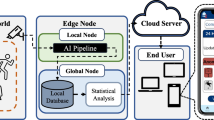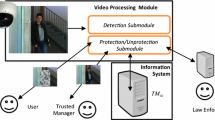Abstract
Especially in urban environments, video cameras have become omnipresent. Supporters of video surveillance argue that it is an excellent tool for many applications including crime prevention and law enforcement. While this is certainly true, it must be questioned if sufficient efforts are made to protect the privacy of monitored people. Privacy concerns are often set aside when compared to public safety and security. One reaction to this situation is emerging: community-based efforts where citizens register and map surveillance cameras in their environment. Our study is inspired by this idea and proposes a user-specific and location-aware privacy awareness system. Using conventional smartphones, users not only can contribute to the camera maps, but also use community-collected data to be alerted of potential privacy violations. In our model, we define different levels of privacy awareness. For the highest level, we present a mechanism that allows users to directly interact with specially designed, trustworthy cameras. These cameras provide direct feedback about the tasks that are executed by the camera and how privacy-sensitive data is handled. A hardware security chip that is integrated into the camera is used to ensure authenticity, integrity and freshness of the provided camera status information.










Similar content being viewed by others
Notes
Mapcams.org went offline due to technical difficulties in fall 2010. At the time of writing this article, it has not yet resumed its services.
References
Baaziz, N., Lolo, N., Padilla, O., Petngang, F.: Security and privacy protection for automated video surveillance. In: Proceedings of the International Symposium on Signal Processing and Information Technology, pp. 17–22 (2007)
Bangerter, E., Djackov, M., Sadeghi, A.R.: A demonstrative ad hoc attestation system. In: Proceedings of the International Conference on Information Security, pp. 17–30 (2008)
BeagleBoard: TI OMAP3530 based Embedded System. http://beagleboard.org. Accessed: April 2011
Boult, T.E.: PICO: Privacy through invertible cryptographic obscuration. In: Proceedings of the Workshop on Computer Vision for Interactive and Intelligent Environments, p. 12 (2005)
Brassil, J.: Using mobile communications to assert privacy from video surveillance. In: Proceedings of the Parallel and Distributed Processing Symposium, p. 8 (2005)
Cavallaro, A.: Adding privacy constraints to video-based applications. In: Proceedings of the European Workshop on the Integration of Knowledge, Semantics and Digital Media Technology, p. 8 (2004)
Cavallaro, A.: Privacy in video surveillance. IEEE Signal Process Mag 24(2), 168–169 (2007)
Chattopadhyay, A., Boult, T.E.: PrivacyCam: a privacy preserving camera using uCLinux on the Blackfin DSP. In: Proceedings of the Conference on Computer Vision and Pattern Recognition, p. 8 (2007)
Cheung, S.C.S., Paruchuri, J.K., Nguyen, T.P.: Managing privacy data in pervasive camera networks. In: Proceedings of the International Conference on Image Processing, p. 4 (2008)
Cheung, S.C.S., Zhao, J., Venkatesh, M.V.: Efficient object-based video inpainting. In: Proceedings of the International Conference on Image Processing, pp. 705–708 (2006)
Chinomi, K., Nitta, N., Ito, Y., Babaguchi, N.: PriSurv: Privacy protected video surveillance system using adaptive visual abstraction. In: Proceedings of the International Multimedia Modeling Conference, p. 144 (2008)
Dufaux, F., Ebrahimi, T.: Scrambling for video surveillance with privacy. In: Proceedings of the Conference on Computer Vision and Pattern Recognition Workshop, pp. 160–166 (2006)
Dufaux, F., Ebrahimi, T.: A framework for the validation of privacy protection solutions in video surveillance. In: Proceedings of the International Conference on Multimedia and Expo, pp. 66–71 (2010)
Fidaleo, D.A., Nguyen, H.A., Trivedi, M.: The networked sensor tapestry (NeST): a privacy enhanced software architecture for interactive analysis of data in video-sensor networks. In: Proceedings of the International Workshop on Video Surveillance and Sensor Networks, pp. 46–53 (2004)
Fleck, S., Straßer, W.: Towards secure and privacy sensitive surveillance. In: Proceedings of the International Conference on Distributed Smart Cameras, p. 7 (2010)
Fleck, S., Strasser, W.: Smart camera based monitoring system and its application to assisted living. Proc IEEE 96(10), 1698–1714 (2008)
Garriss, S., Cáceres, R., Berger, S., Sailer, R., van Doorn, L., Zhang, X.: Trustworthy and personalized computing on public kiosks. In: Proceedings of the International Conference on Mobile Systems, Applications, and Services, pp. 199–210 (2008)
Gehring, S., Gisch, M.: The privacy badge revisited—enhancement of a privacy-awareness user interface for small devices. In: Proceedings of the Workshop on Security and Privacy Issues in Mobile Phone Use, p. 8 (2008)
Gisch, M., Luca, A.D., Blanchebarbe, M.: The privacy badge: a privacy-awareness user interface for small devices. In: Proceedings of the International Conference on Mobile Technology, Applications, and Systems and the International Symposium on Computer Human Interaction in Mobile Technology, pp. 583–586 (2007)
Goodrich, M.T., Sirivianos, M., Solis, J., Tsudik, G., Uzun, E.: Loud and clear: human-verifiable authentication based on audio. In: Proceedings of the International Conference on Distributed Computing Systems, p. 10 (2006)
IBM: TrouSerS TCG Software Stack. http://trousers.sourceforge.net. Accessed: April 2011
Langheinrich, M.: A privacy awareness system for ubiquitous computing environments. In: Proceedings of the International Conference on Ubiquitous Computing, pp. 315–320 (2002)
Luo, Y., Ye, S., Samson Cheung, S.c.: Anonymous subject identification in privacy-aware video surveillance. In: Proceedings of the International Conference on Multimedia and Expo, pp. 83–88 (2010)
Mapcams.org: Mapcams.org Website. http://www.mapcams.org/. Accessed: September 2010
Martin, A.: The ten page introduction to trusted computing. Tech. Rep. RR-08-11, Oxford University Computing Laboratory (2008)
McCune, J.M., Perrig, A., Reiter, M.K.: Seeing-is-believing: using camera phones for human-verifiable authentication. Int. J. Secur. Netw. 4(1/2), 43–56 (2009)
Mohan, A., Woo, G., Hiura, S., Smithwick, Q., Raskar, R.: Bokode: imperceptible visual tags for camera based interaction from a distance. In: Proceedings of the International Conference on Computer Graphics and Interactive Techniques, pp. 1–8 (2009)
Moncrieff, S., Venkatesh, S., West, G.: Dynamic privacy in public surveillance. IEEE Comput 42(9), 22–28 (2009)
OpenStreetMap.org: OpenStreetMap.org Video Surveillance Camera Overlay. http://osm.vdska.de. Accessed: April 2011
OWNI: CCTV Camera Positions in Paris. http://app.owni.fr/camera-paris/ (2011). Accessed: April 2011
Parno, B.: Bootstrapping trust in a “trusted” platform. In: Proceedings of the Usenix Workshop on Hot Topics in Security, p. 6 (2008)
Pirker, M., Tögl, R., Hein, D., Danner, P.: A PrivacyCA for anonymity and trust. In: Proceedings of the International Conference on Trusted Computing, pp. 101–119 (2009)
Prefecture de Police: Plan de Vidéoprotection pour Paris. http://www.prefecturedepolice.interieur.gouv.fr/Prevention/Videoprotection/Plan-de-videoprotection-pour-Paris (2010). Accessed: April 2011
Rahman, S.M.M., Hossain, M.A., Mouftah, H., Saddik, A.E., Okamoto, E.: A real-time privacy-sensitive data hiding approach based on chaos cryptography. In: Proceedings of the International Conference on Multimedia and Expo, pp. 72–77 (2010)
Saini, M., Atrey, P.K., Mehrotra, S., Emmanuel, S., Kankanhalli, M.: Privacy modeling for video data publication. In: Proceedings of the International Conference on Multimedia and Expo, pp. 60–65 (2010)
Schiff, J., Meingast, M., Mulligan, D.K., Sastry, S., Goldberg, K.Y.: Respectful cameras: selecting visual markers in real-time to address privacy concerns. In: Proceedings of the International Conference on Intelligent Robots and Systems, pp. 971–978 (2007)
Schriebl, W., Winkler, T., Starzacher, A., Rinner, B.: A pervasive smart camera network architecture applied for multi-camera object classification. In: Proceedings of the International Conference on Distributed Smart Cameras, p. 8 (2009)
Selhorst, M., Stüble, C., Feldmann, F., Gnaida, U.: Towards a trusted mobile desktop. In: Proceedings of the International Conference on Trusted Computing, pp. 78–94 (2010)
Senior, A., Pankanti, S., Hampapur, A., Brown, L., Tian, Y.L., Ekin, A., Connell, J., Shu, C.F., Lu, M.: Enabling video privacy through computer vision. IEEE Secur. Priv. Mag. 3(3), 50–57 (2005)
Spindler, T., Wartmann, C., Hovestadt, L., Roth, D., van Gool, L., Steffen, A.: Privacy in Video Surveilled Areas. In: Proceedings of the International Conference on Privacy, Security and Trust, p. 10 (2006)
Tansuriyavong, S., Hanaki, S.: Privacy Protection by concealing Persons in circumstantial Video Image. In: Proceedings of the Workshop on Perceptive User Interfaces, pp. 1–4 (2001)
Tarnovsky, C.: Hacking the smartcard chip. In: Black Hat DC Presentations (2010)
Tögl, R.: Tagging the turtle: local attestation for kiosk computing. In: Proceedings of the International Conference on Advances in Information Security and Assurance, pp. 60–69 (2009)
Tögl, R., Hutter, M.: An approach to introducing locality in remote attestation using near field communications. J Supercomput 55, 1–21 (2010)
Troncoso-Pastoriza, J.R., Pérez-Freire, L., Pérez-gonzález, F.: Videosurveillance and privacy: covering the two sides of the mirror with DRM. In: Proceedings of the Workshop on Digital Rights Management, pp. 83–94 (2009)
Trusted Computing Group: TCG Website. https://www.trustedcomputinggroup.org. Accessed: November 2010
Trusted Computing Group: TCG Software Stack Specification (TSS) Version 1.2, Level 1, Errata A (2007)
Trusted Computing Group: TPM Main Specification Version 1.2, Level 2, Revision 103 (2007)
Wickramasuriya, J., Datt, M., Mehrotra, S., Venkatasubramanian, N.: Privacy protecting data collection in media spaces. In: Proceedings of the International Conference on Multimedia, pp. 48–55 (2004)
Winkler, T., Rinner, B.: A systematic approach towards user-centric privacy and security for smart camera networks. In: Proceedings of the International Conference on Distributed Smart Cameras, p. 8 (2010)
Winkler, T., Rinner, B.: TrustCAM: security and privacy-protection for an embedded smart camera based on trusted computing. In: Proceedings of the International Conference on Advanced Video and Signal-Based Surveillance, pp. 593–600 (2010)
Winkler, T., Rinner, B.: User-based attestation for trustworthy visual sensor networks. In: Proceedings of the Conference on Sensor Networks, Ubiquitous, and Trustworthy Computing, p. 8 (2010)
Winkler, T., Rinner, B.: Securing embedded smart cameras with trusted computing. EURASIP J. Wirel. Commun. Netw. 2011, 20 (2011) (Special Issue on Security and Resilience for Smart Devices and Applications)
Yabuta, K., Kitazawa, H., Tanaka, T.: A new concept of security camera monitoring with privacy protection by masking moving objects. In: Proceedings of the Pacific-Rim Conference on Multimedia, p. 12 (2005)
Ye, S., Luo, Y., Zhao, J., Cheung, S.C.S.: Anonymous biometric access control. EURASIP J. Inf. Secur. 2009, 18 (2009). (Special Issue on Enhancing Privacy Protection in Multimedia Systems)
ZXing Community: Zebra Crossing (ZXing) Multi-format 1D/2D Barcode Image Processing Library. web: http://code.google.com/p/zxing. Accessed: November 2010
Author information
Authors and Affiliations
Corresponding author
Rights and permissions
About this article
Cite this article
Winkler, T., Rinner, B. User-centric privacy awareness in video surveillance. Multimedia Systems 18, 99–121 (2012). https://doi.org/10.1007/s00530-011-0241-1
Published:
Issue Date:
DOI: https://doi.org/10.1007/s00530-011-0241-1




